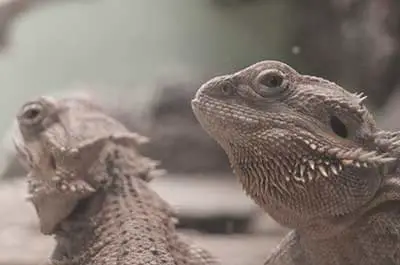There’s a lot to know about bearded dragons if you’re thinking of adding one to your family. They’re adorable and make great pets, but they do require a bit of special care. If you’re considering making a bearded dragon your new best friend, read on for some tips to help you get started.
What do bearded dragons eat, and how much should they be fed daily?
Bearded dragons are omnivores, which means they eat both plants and animals. Their diet consists mostly of insects in the wild, but they will also eat small mammals, reptiles, and birds. In captivity, they can be fed a diet of commercially available bearded dragon food, vegetables, and live insects.
A bearded dragon’s diet should consist of about 20% insects, such as crickets and mealworms, and 80% vegetables (baby bearded dragons need these ratios flipped), such as dark leafy greens and squash. Be sure to dust the insects with a calcium supplement before feeding them to your dragon.
Regarding how much to feed them, it depends on the age and size of your bearded dragon. Juvenile dragons (up to 6 months old) should be offered food once or twice a day, while adult dragons can be fed every other day. The amount of food each dragon needs will also vary based on their size; a good rule of thumb is to offer them as much food as they can eat in one sitting.
What are the housing and temperature requirements for bearded dragons?
Bearded dragons need a warm, dry environment to thrive. In the wild, they live in an arid desert where temperatures can reach over 100 degrees Fahrenheit during the day. In captivity, they should be kept at a temperature between 75 and 85 degrees Fahrenheit.
Bearded dragons also need a place to bask, so their enclosure should have a basking spot with a heat lamp. The basking spot should be kept at around 95 degrees Fahrenheit. The rest of the enclosure can be kept at the lower end of the temperature range (75-85 degrees).
Bearded dragons also need UVB light to help them absorb calcium. This can be provided with a special UVB bulb or by taking your dragon outside for a few hours each week.
The basics of breeding bearded dragons.
If you’re interested in breeding bearded dragons, there are a few things you need to know.
First, you’ll need to have a male and female dragon.
Second, the enclosure must be large enough to accommodate multiple dragons (10-15 gallons per dragon is a good rule of thumb).
Third, the temperature and humidity levels in the enclosure must be carefully monitored. The temperature should be between 80 and 85 degrees Fahrenheit, and the humidity should be between 30 and 40%.
Finally, you’ll need to provide plenty of places for the dragons to hide, as they can be aggressive toward each other during the breeding season.
How to handle a bearded dragon properly?
When handling a bearded dragon, it’s important to be gentle and avoid sudden movements. Bearded dragons are fragile creatures, and their skin can tear easily. Start by getting your dragon used to you. Spend time around them daily, letting them get used to your smell and presence. When it comes time to pick them up, do so slowly and gently. Support their whole body, including their tail. Avoid holding them too close to your face, as they may mistake you for food!
Bearded dragons are gentle creatures that make great pets. With proper care, they can live for 10-15 years. If you’re thinking of adding one to your family, be sure to do your research to ensure you can provide them with the care they need.
They can be quite social and enjoy interacting with their owners.
If you’re thinking of getting a bearded dragon, one of the first things you should know is that they can be quite social creatures. While they’re not as cuddly as a cat or a dog, they enjoy interacting with their owners and can even be trained to do simple tricks.
If you want your beardie to bond with you, here are a few tips:
- Spend time with them every day, even if it’s just a few minutes. Let them out of their enclosure so they can explore, and offer them some food from your hand.
- Be patient. It takes time for them to get used to you and vice versa.
- Be consistent in your handling. If you pick them up frequently, they’ll become accustomed to it and be less anxious.
With a little time and effort, you can develop a strong bond with your bearded dragon; after all, who doesn’t love a reptile that enjoys a good head scratch?
Male bearded dragons will often puff out their throats to show dominance.
One of the most common displays of dominance among male bearded dragons is throat puffing. When a male dragon puffs out his throat, he is essentially trying to make himself look bigger and more intimidating.

This behavior is often seen during mating season when males are competing for the attention of females. However, it can also occur during territorial disputes with other males. In many cases, throat puffing is simply a harmless way for dragons to assert their authority.
However, it can sometimes escalate into physical violence. For this reason, it’s important to be careful when handling multiple dragons at once. If you see signs of throat puffing, be sure to give the dragons some space and allow them to resolve the situation on their own.
When frightened or stressed, bearded dragons may “blue”.
If you see your bearded dragon turning blue, don’t be alarmed – this is perfectly normal. Dragons will often “blue” when they are frightened or stressed. This is a defense mechanism that helps them blend in with their surroundings and avoid being seen by predators.
While it’s nothing to worry about, be sure to take note of the circumstances in which your dragon turns blue. If it happens frequently, it may signify that they are not comfortable in their environment. In this case, you’ll need to make some changes to their enclosure to help reduce their stress levels.
Bearded dragons are native to Australia.
Bearded dragons are native to Australia and can be typically found in warm and arid areas. They are named for the spines that line their necks, which resemble the whiskers of a dragon. Bearded dragons usually grow to be about two feet long, and they can live between 4 and 10 years.
In the wild, bearded dragons’ range extends across most of Australia. They typically prefer to stick to warm, arid areas: deserts, subtropical woodlands, savannas, and scrublands.
A warm habitat is crucial for bearded dragons. They’re cold-blooded and rely on external heat sources to raise their body temperature, which varies according to the temperature of their environment. They bask in the sun to warm themselves and can burrow underground to avoid extreme heat and predators.
In captivity, however, they can be found all over the world. Thanks to their docile nature and unique appearance, bearded dragons have become popular pets in recent years. They’ve been bred in the United States for decades for the pet trade, and they come in various color “morphs” not commonly found in the wild.
How to identify if your bearded dragon is sick or injured?
There are a few things to look for that may indicate your bearded dragon is sick or injured.
If you notice any of the following, it’s best to take them to see a vet as soon as possible:
- lethargy
- loss of appetite
- difficulty breathing
- swollen joints
- open wounds
- cloudy eyes
- mucus in the mouth or nose
- unusual behavior ( aggression, irritability, etc. )
If you notice any of these symptoms, it’s best to take your dragon to see a vet as soon as possible.
Bearded dragons are susceptible to several health problems, so it’s important to keep an eye on them and take them to the vet for regular check-ups. Some common health problems include parasites, respiratory infections, and metabolic bone disease.
To prevent these problems, it’s important to provide your dragon with a well-balanced diet, a clean and spacious enclosure, and plenty of opportunities to bask in the sun.
Male bearded dragons are usually larger than females.
Male bearded dragons are usually larger than females, and they can grow up to three feet long. Bearded dragons may be distinguished by their sexes based on the size of their heads; females have smaller brain cases, while males have bigger, thicker, and broader skulls.
In addition to their size difference, Male bearded dragons have two hemipenal bulges, whereas female bearded dragons only have one.
There isn’t much difference between male and female bearded dragons regarding personality. However, some believe females are usually more docile and easy-going than males.
Conclusion.
Bearded dragons are unique and interesting pets that can make great companions. If you’re thinking about getting one, do your research and learn everything you can about them beforehand.
Your bearded dragon can live a long and healthy life with proper care. So, if you’re up for the challenge, go ahead and add one of these amazing creatures to your family! Thanks for reading!

Dive into the insights of Matthew Mansour, a seasoned life coach, fitness guru, and health mentor. With a portfolio boasting over 800 thought-provoking articles, Matthew is passionate about unraveling the intricate layers of the human psyche. His reading choices? Books that shed light on our unique human journey, helping him (and his readers) harness the power of the mind, transforming challenges into stepping stones.
Matthew proudly wears his badge as a self-help aficionado. His mantra? There’s always room to grow, learn, and be inspired. He thrives on gleaning wisdom from pioneers, turning their experiences into valuable lessons for all.
Always on the pulse of emerging trends, Matthew immerses himself in groundbreaking courses and research centered around life coaching and holistic health. Eager to impart his knowledge, he’s here to guide anyone keen on enhancing their life journey.
Beyond his professional persona, Matthew is a devoted animal lover, a proud New Jersey resident, and a doting husband and father. Dive into his self-improvement blog and let Matthew guide you towards a life filled with purpose and passion!
Reviewed By: Joanna Perez and Marcella Raskin
Edited By: Lenny Terra
Fact Checked By: Gabrielle J. Smith
Photos Taken or Curated By: Matthew Mansour

